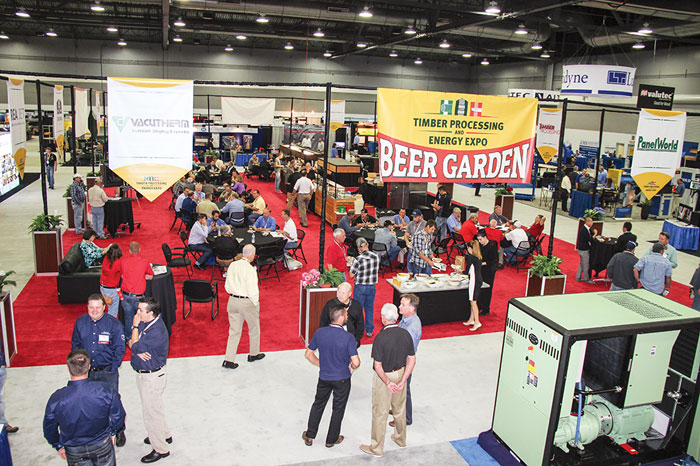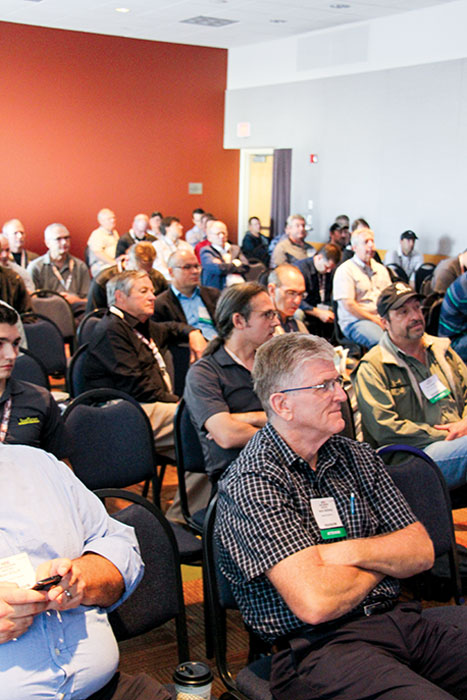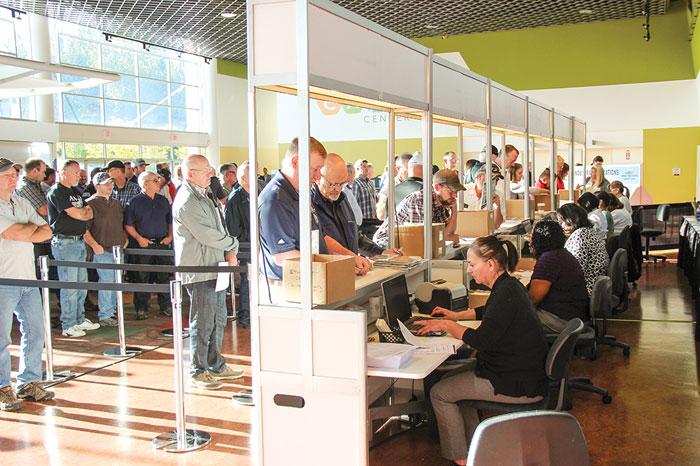“I did spend a bit of time there for the first time in several years and was impressed with the quality/quantity of vendors and new ideas. We are always interested in grade scanning, process control and general optimization developments. I look forward to the next show.”
—Northwest lumberman“I found the show very worthwhile and was surprised with how well attended it was. The opportunity for face-to-face contact with the network of people I interact with in the industry is invaluable.”—Southeast lumberman
About 1,600 industry (non-exhibitor) personnel, representing 110 forest products producer companies and hundreds of individual mill site operations, attended the third Timber Processing & Energy Expo held September 28-30 at the Portland Exposition Center.
The event, produced by Hatton-Brown Expositions, LLC—an affiliate of Hatton-Brown Publishers, Inc., Timber Processing and Panel World magazines—caters to primary producers of lumber, veneer-plywood and engineered wood products.
“Attendance from the mills was up about 10% from 2014, which we thought was solid considering the number of mill closures and consolidations in the Northwest during the past two years,” comments Show Director Rich Donnell.
About 1,100 exhibitor personnel were also in attendance. (Total registration was 3,000—1,800 non-exhibitors and 1,200 exhibitors, but as is typical about 10% of free pre-registration were no-shows.)
Attendees from 39 U.S. states, six Canadian provinces, and 20 countries besides the U.S. and Canada came to view 225 exhibiting companies on 60,000 sq. ft. of booth space.
“Everyone seemed to enjoy having more room to work with,” says Donnell, referring to the event’s move into Hall E on the expo grounds from its previous location next door in Hall D. “Hall E is a third larger than Hall D was, and this allowed us to put in a large Beer Garden for people to sit down and relax in, and overall just more space to move around in between the exhibits.”
The technology was everywhere and more big machinery was showcased than in previous events. It also included for the first time German and Italian pavilions featuring exhibitors from those countries.
“We are currently working on Capex for next year,” comments Chuck Morgan, general manager at SYP producer Suwannee Lumber in Florida. “I was looking for equipment in the sawmill and planer mill—graders, gang, profiler, infeed etc., really for informational and budgetary purposes. The show was nice and informational. It is good to see many of the industry suppliers in one location and offers much more opportunity for exposure to other products or ‘brands’ than we currently use.”
Former Timber Processing Man of the Year, Jim Quinn, now Chairman of the Board and acting CEO of White Mountain Apache Timber Co. in Arizona, was making the rounds.
“The White Mountain Apache Timber Company is pretty far behind on technology and basically we need to replace our small log mill and include mechanical sorting on the next one. We also need a sorter for the Stetson Ross planer and we may want to do some mechanization in the log yard,” Quinn says.
Quinn notes that the Tribe has more than 700,000 acres of very nice ponderosa pine. They currently operate a double cut headrig and a single cut headrig in the large log mill, and an aging double length infeed system in the small log mill. The mill operates two planer lines.
Many forest products companies and mills encouraged mill management and operators to attend TP&EE. Weyerhaeuser had 98 in attendance; Sierra-Pacific Industries, 66; Hampton, 46. Stimson Lumber, Alta Forest Products, Seneca, Idaho Forest Group, Roseburg and several other companies also sent large contingents.
Mike Pederson, president and CEO of Alta Forest Products, which operates several sawmills in the Northwest, said they attended for two reasons. One was to meet with an exhibitor to review the latest upgrades in automated planer grading. “But the main reason, and the reason for so many of our people there, is that I like to get our people away from the plant to see what is new and innovative within our industry. The show in Portland is a great venue for that,” Pederson says.
“Attendance from the Northwest U.S. and Western Canada was strong as we expected,” Donnell comments. “But I was pleased by so many representatives from mills in the Southeast and up into Maine.”
Most exhibitors found that most attendees were upbeat and had investments in mind. Several machines had “sold” signs on them, such as a Gilbert planer going to Seneca Sawmill, a Samuel packaging system to Sierra-Pacific and a Corley carriage to Canfor-Beadles.
“The level of optimism was striking,” comments Joey Nelson, president of JoeScan. “It has taken a long time for the industry to recover. Now that mills are on stronger footing, there are a lot of opportunities to make solid investments in improving the productivity and efficiency of their operations.”
JoeScan introduced a six-laser, high-density carriage scanner, the JS-25 X6B.
“The show was great. We were very happy with the quality and quantity of attendees and exhibitors,” comments Jesse Vigil, president and CEO of Metal Detectors Inc. “The Portland Expo Center is a perfect venue, and the show floor was very spacious. We really liked the wide aisles and spacing of the booths.”
MDI emphasized its TWA-2000-HD system that is used for scanning whole logs and received a lot of interest in this system from customers and distributors, as well as positive feedback from customers who are already running it in their sawmills.
“We had solid leads from decision makers in attendance,” Vigil adds. “We drew customers from many parts of the U.S. as well as Canada. Everyone seemed very upbeat and optimistic with the amount of building that is currently going on. Lumber suppliers need quality equipment in order to meet market demand. There seems to be a positive outlook throughout the industry.”
Spriinger Microtec CTO Norvin Laudon says the event confirmed what he had thought going into it. “Two years ago we were relative newcomers and unknown, and this year pretty much everyone who came knew who we are and what we do.”
Microtec set up its Goldeneye 900 multisensor board scanner and Springer screw feeder as well as a miniature of the E-Cut board trimmer.
“Despite the looming softwood lumber agreement uncertainty, I got the impression the market is strong and the customers were making investments,” Laudon adds. “There were many customers who came to the booth, and some will develop into solid projects.”
USNR attracted considerable attention with its large booth that featured four vertically standing pieces of cross-laminated timber, each with one of the U-S-N-R letters sawn out. The company also emphasized its all-electric lumber handling equipment, displaying the ElectraTong Lug Loader and the Multi-Track Fence, of which more than 100 have sold since its inception several years ago.
A CamShift 600 Cambio debarker, new to the North American market, was also on display. The system combines debarking and flare reducing in a single, modular machine.
“A major benefit of the CamShift is a significant reduction in the consumption of oil and air,” comments Sonia Perrine, senior marketing associate. “Setup and tool changes are a breeze with its modular, pull-out design. Variations accommodate minimum log length and top or butt-end feeding.”
Perrine felt they definitely had some good potential customers, as well as existing ones, visit the booth. “The election has people on a merry-go-round that has put a few buying decisions on hold. It is clear that the industry is interested in doing things if the politics are favorable.”
USNR also hosted a popular tent eatery in front of the expo hall.
Andritz showed its new powerheads (solid canter heads for primary and secondary canters) and its new Drum Style Chip-N-Saw heads for four-sided canters and profiler machines, as well as its new Turnknife System 4 for sawmill chippers.
“This is the same knife system we have been installing in whole log chippers the past several years and we are now applying this technology and knowledge to sawmill chippers,” comments Bill Beck, North American sawmill manager. “We are seeing outstanding performance of this knife system on sawmill chippers all over North America.”
Beck says they had several very good conversations with potential new customers. “Everyone is doing good right now. The Canadians are worried about the SLA expiring and what is going to happen to tariffs, duties, quotas, etc., but they operated for years under an agreement and prospered. Mills in the U.S. are marching forward with upgrades.”
BID Group and its range of companies presented three new products, including the Miller planer, McGehee profiling machine and the new generation of GradExpert.
“For us it is very important to show new products as it reflects our continuous work to improve actual products and offer new products to the market,” comments Anne-Marie Levesque, marketing manager. “Our executive team stays focused on innovation and research & development.”
Levesque says there was very high-quality people in attendance and many of those people were looking for short- and mid-term investments, upgrading their mill and operations to keep up the pace with the market.
“The feeling of this show was great,” Levesque adds. “We feel the industry is alive and is looking forward for the good years of business to come.”
During the show BID Group organized tours of the SDS Lumber planer mill at Bingen, Wash. This is a new turnkey installation that started up two months ago. “We brought about 50 customers there, so that confirms that people are looking for serious investment and wanted to check on this first-hand.”
One of BID Group’s newer members, Ron McGehee, also spoke during the Lumber Manufacturing Workshop held on the second day of the show.
McGehee’s talk on The Latest Profiling Technologies was one of 17 presentations during the Lumber Manufacturing Workshop, which had simultaneous sessions going on in adjacent rooms. Two-hundred people attended the workshops, bouncing from one room to the other, though most of them gathered for McGehee’s presentation.
McGehee noted early in his talk that the objective of his profiling system is to improve productivity and recovery and reduce manufacturing costs. He pointed to a reduction of costs of $25/MBF in recent projects, an increase in production up to 25% and an increase in recovery of up to 3% in some mills.
He said the installation of the profiler means production is not limited by the edger anymore (up to 60% less boards going to the edger); most of the products from the gang are finished, and there’s less downtime.
Profiling on a solid piece of wood like a cant at slower speed (600 FPM max) showed with time that edging accuracy is better than an edger going at 1200 FPM, McGehee stated. A typical payback on the profiler in a 150MMBF mill is just under eight months, he added.
McGehee said there are two typical arrangements: as a standard profiler, for gangs fed by belt conveyor by centering chain systems; and as an infeed profiler, for gangs fed by a centering chain system and where space is limited, with the unit replacing the existing curve-saw infeed module.
The profiler includes disc chipping heads for the surface finish, independent profiling heads with infinite positioning, and skew and slew movement.
Yvan Rainville, vice-president sales and marketing for Autolog, addressed the company’s new modular scanner frame and also split & shake detection at the trimmer optimizer, using 3D identification.
He cited a case study at Tolko Lakeview on a 20 ft. trimmer optimizer with a “conservative payback of salvaged volume of approximately $168,000/year,” and additional savings of $6,000 in drying costs, as well as increased performance at the planer, reduced blockage in downstream sorter and stacker, and improved sorting of high grade products at the sawmill.
He also addressed Autolog’s unsound wood detection system, pointing to positive results at Forex on a 16 ft. trimmer optimizer with annual savings of $108,000 for a production of about 100MMBF. Benefits included reduced handling inside and outside the sawmill and increased chip quality, with savings of approximately $6,000 per year due to staying within chip value norm, $36,000 a year due to increased kiln capacity and decreased handling, and $66,000 annually due to increased planer capacity and decreased handling.
Michel Loyet, CEO of Finega Group of France, presented the company’s new MasterTwin 3D end dogging log breakdown system. Prior to the cutting line, each log is scanned by a 360° rotary scanner which scans the full shape of the log during the cutting sequence of the previous log. An optimizer calculates the best sawing axis and cutting pattern in the 3D space based on mill production and value parameters.
Ellen Nelson, chief financial officer of Lucidyne, and Ryan Shear, lead optimization engineer, spoke on their GradeScan planer mill grader and said customers start seeing ROI in less than eight months while improving the consistency and overall quality of lumber.
They noted that its compact lineal design means that most mills make very few changes to their existing line, and installs in just two weekends with little or no downtime. They also addressed the GradeScan True-Q lumber tracking system, and warp detection.
They emphasized the GradeScan’s tracheid sensor and T3 sensor. “If you can’t see knots behind blue stain, you don’t have a Lucidyne GradeScan,” Nelson said.
With regard to the system optimization, Nelson said, “Here’s a great story: The sales manager at one of our customers’ locations came into the mill and said that he had customer demand for a niche product. He asked how long it would take for the mill to start making it. Without a moment’s hesitation, the mill manager said, ‘Come back after lunch.’ That’s flexibility.”



